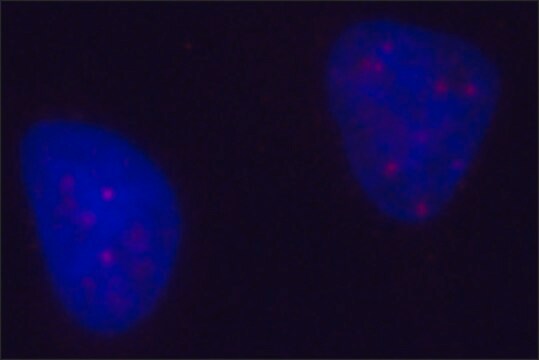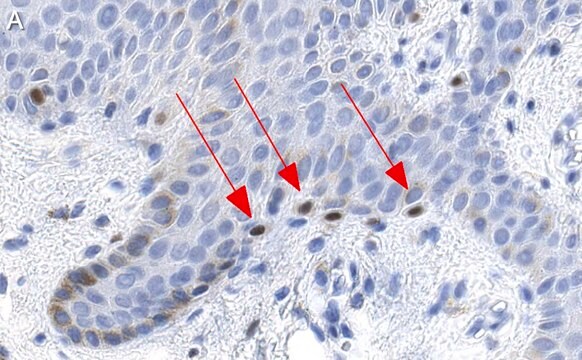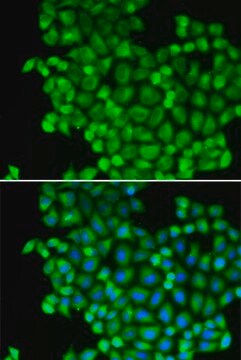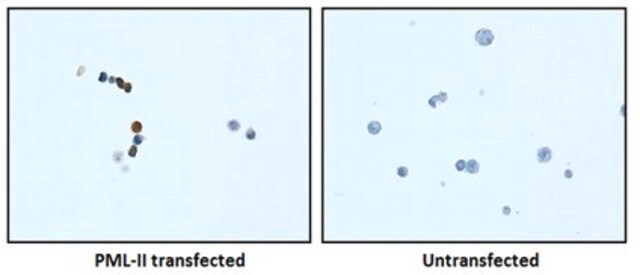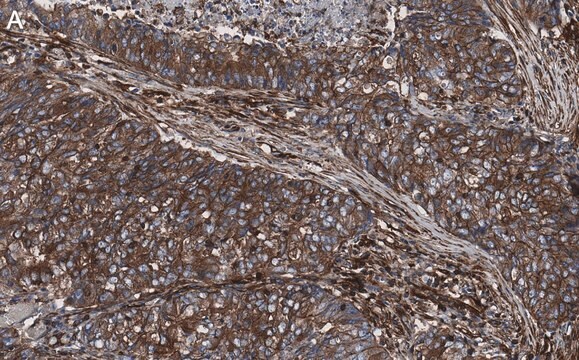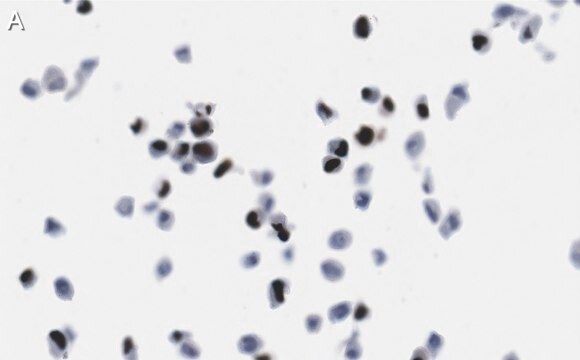詳細
We are committed to bringing you greener alternative products, which adhere to one or more of The 12 Principles of Green Chemistry.This antibody is Preservative-free, produced without the harm or sacrifice of animals and exceptionally stable to allow for ambient shipping and storage if needed and thus aligns with "Waste Prevention", "Designing Safer Chemicals" and "Design for Energy Efficiency".
Click here for more information.
ZooMAb® antibodies represent an entirely new generation of recombinant monoclonal antibodies.
Each ZooMAb® antibody is manufactured using our proprietary recombinant expression system, purified to homogeneity, and precisely dispensed to produce robust and highly reproducible lot-to-lot consistency. Only top-performing clones are released for use by researchers. Each antibody is validated for high specificity and affinity across multiple applications, including its most commonly used application. ZooMAb® antibodies are reliably available and ready to ship when you need them.
特異性
Clone 1F13 is a ZooMAb® Rabbit recombinant monoclonal antibody that specifically detects Promyelocytic leukemia protein (PML). It targets an epitope within 19 amino acids from the N-terminal region.
免疫原
KLH-conjugated linear peptide corresponding to 19 amino acids from the N-terminal region of human Promyelocytic leukemia protein (PML).
アプリケーション
Quality Control Testing
Evaluated by Western Blotting in NIH3T3 cell lysate.
Western Blotting Analysis: A 1:1,000 dilution of this antibody detected PML in NIH3T3 cell lysate.
Tested applications
Western Blotting Analysis: A 1:1,000 dilution from a representative lot detected PML in HeLa and L6 cell lysates.
Immunocytochemistry Analysis: A 1:1,000 dilution from a representative lot detected PML in A431 cells.
Affinity Binding Assay: A representative lot of this antibody bound PML with a KD of 1.1 x 10-8 in an affinity binding assay.
Immunohistochemistry (Paraffin) Analysis: A 1:100 dilution from a representative lot detected PML in human colon tissue sections.
Note: Actual optimal working dilutions must be determined by end user as specimens, and experimental conditions may vary with the end user
ターゲットの説明
Protein PML (UniProt: P29590; also known as E3 SUMO-protein ligase PML, Promyelocytic leukemia protein, RING finger protein 71, RING-type E3 SUMO transferase PML, Tripartite motif-containing protein 19, TRIM19) is encoded by the PML (also known as MYL, PP8675, RNF71, TRIM19) gene (Gene ID: 5371) in human. PML is the eponymous and main structural component of the PML nuclear bodies (PML NBs). It is involved in a variety of cellular processes, including tumor suppression, transcriptional regulation, apoptosis, senescence, DNA damage response, and viral defense mechanisms. It has been reported that PML recognizes misfolded proteins and acts as a SUMO E3 ligase by promoting the attachment of SUMO to these substrates. PML preferentially catalyzes modification with the SUMO2/SUMO3 variants that are prone to the formation of polymeric SUMO chains. SUMO2/SUMO3 chains subsequently serve as a docking site for RNF4, which earmarks the misfolded proteins for proteasomal degradation by adding a ubiquitin tag. PML protein is localized in the nucleus and in cytoplasm. 14 different isoforms of PML have been described that are produced via alternative splicing. Isoform PML-1 is shown to shuttle between the nucleus and cytoplasm and Isoforms 2-6 are localized in the nucleus. Some isoforms, such as PLML 7 and 14 lack nuclear localization signal and are only cytosolic. Acetylation at Lys-487 is shown to be essential for its nuclear localization. Within the nucleus, most of PML is expressed in the diffuse nuclear fraction of the nucleoplasm and only a small fraction is found in the matrix-associated PML-NBs. The transfer of PML from the nucleoplasm to PML-NBs is dependent on its phosphorylation and sumoylation. The B1 box (aa 124-166) and the RING finger (aa 57-92) zinc fingers are also required for the localization in PML-NBs. PML is also observed in mitochondria-associated membranes (MAMs) that connect the endoplasmic reticulum (ER) and the mitochondria. This ZooMAb® recombinant monoclonal antibody, generated by our propriety technology, offers significantly enhanced specificity, affinity, reproducibility, and stability over conventional monoclonals. (Ref.: Guo, L., et al. (2014). Mol. Cell 55(1); 15-30; Chu, Y., and Yang, X. (2011). Oncogene. 30(9): 1108-1116).
物理的形状
Purified recombinant rabbit monoclonal antibody IgG, lyophilized in PBS, 5% Trehalose, normal appearance a coarse or translucent resin. The PBS/trehalose components in the ZooMAb formulation can have the appearance of a semi-solid (bead like gel) after lyophilization. This is a normal phenomenon. Please follow the recommended reconstitution procedure in the data sheet to dissolve the semi-solid, bead-like, gel-appearing material. The resulting antibody solution is completely stable and functional as proven by full functional testing. Contains no biocide or preservatives, such as azide, or any animal by-products. Larger pack sizes provided as multiples of 25 μL.
再構成
300 μg/mL after reconstitution at 25 μL per vial. Please refer to guidance on suggested starting dilutions and/or titers per application and sample type.
保管および安定性
Recommend storage of lyophilized product at 2-8°C; Before reconstitution, micro-centrifuge vials briefly to spin down material to bottom of the vial; Reconstitute each vial by adding 25 μL of filtered lab grade water or PBS; Reconstituted antibodies can be stored at 2-8°C, or -20°C for long term storage. Avoid repeated freeze-thaws.
法的情報
ZooMAb is a registered trademark of Merck KGaA, Darmstadt, Germany
免責事項
Unless otherwise stated in our catalog or other company documentation accompanying the product(s), our products are intended for research use only and are not to be used for any other purpose, which includes but is not limited to, unauthorized commercial uses, in vitro diagnostic uses, ex vivo or in vivo therapeutic uses or any type of consumption or application to humans or animals.

